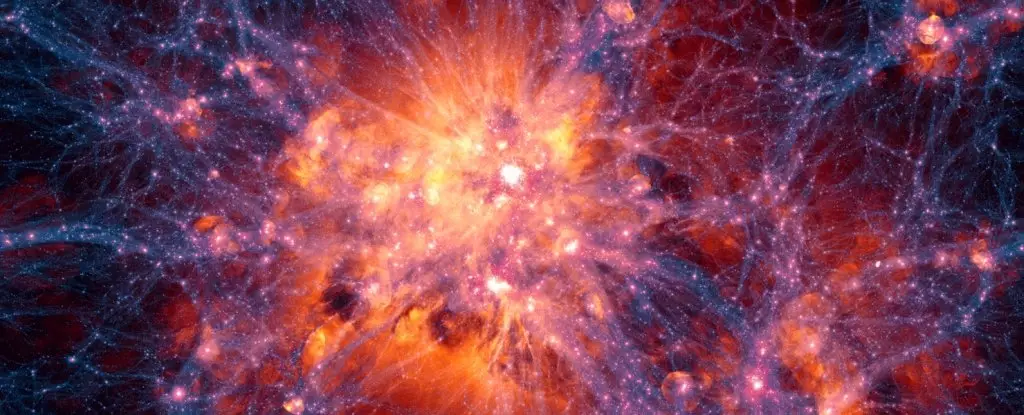Albert Einstein’s theory of general relativity has long served as a cornerstone in our understanding of the universe, describing the gravitational interactions amongst celestial bodies. Recent advancements in astronomical techniques confirm that this theory remains valid even at vast cosmological scales. A groundbreaking study led by a dedicated team of astronomers has meticulously charted the distribution of nearly 6 million galaxies spanning 11 billion years of the universe’s history, providing substantial evidence supporting the foundations laid by Einstein. This monumental effort represents one of the most significant validations of general relativity to date and emphasizes the theory’s significance in explaining the intricate dance of cosmic structures.
Utilizing the Dark Energy Spectroscopic Instrument (DESI), a state-of-the-art astronomical tool operational since 2019, researchers have conducted an extensive survey to map the distribution and evolution of galaxies throughout the history of the universe. This comprehensive project has involved analyzing data from the first year of DESI’s observations, providing insights into how galaxies have resisted the expansive forces driving the universe’s growth. By observing how galaxies congregate along the filaments of the cosmic web, scientists can glean vital information about gravitational dynamics.
Lead researcher Pauline Zarrouk of the French National Center for Scientific Research emphasizes that general relativity has been well tested within the confines of our solar system, but validating its predictions on cosmological scales is paramount. The analysis reveals that the behavior of galaxies aligns remarkably with the theoretical predictions of general relativity, reaffirming its applicability across vast cosmic expanses. This not only augments our understanding of cosmic structures but also reinforces Einstein’s monumental contributions to physics.
Gravity remains an enigmatic yet fundamental force in shaping the universe. Despite its widespread effects, scientists are still unraveling the complexities of why objects with mass attract one another and how this interaction manifests at various scales. Underlying the cosmic web are vast strands of dark matter that serve to bind galaxies together, acting like a glue that anchors the universe itself. This network, vast and intricate, raises questions regarding the nature of dark matter and energy, as well as how they influence the universe’s large-scale structure.
The survey conducted by DESI has not only advanced our knowledge of galactic distribution but also allowed for constraints on dark matter and energy models. By scrutinizing the cosmic web, researchers hope to shed light on these elusive constituents of the universe and their actual roles in cosmic evolution. The delicate balance created by these forces is critical to understanding how the universe behaves today.
The implications of this monumental research span far beyond confirming the validity of general relativity. They bring us closer to understanding not only the nature of dark matter but also the mysterious dark energy that governs the accelerating expansion of the universe. Dark matter constitutes approximately one-quarter of the universe, while dark energy is estimated to make up around 70 percent—yet both phenomena remain poorly understood.
The recent findings from the DESI Collaboration have allowed researchers to impose new constraints on the upper limits of neutrino mass, a particle shrouded in uncertainty. As scientists continue to analyze data from DESI’s subsequent years, which will collect information on over 40 million galaxies and quasars, the potential for groundbreaking discoveries remains immense. The knowledge gathered could ultimately provide answers to some of the biggest questions in cosmology.
As DESI continues its extraordinary mission to map the universe, the ongoing collaboration opens the door to endless possibilities. Dragan Huterer from the University of Michigan stresses the importance of this research in probing modified gravity and enhancing constraints on dark energy models. This is merely the beginning; the growing repository of cosmological data may unravel mysteries that currently baffle physicists.
The endeavor to capture the universe through observational astronomy is a monumental task, yet each piece of data collected adds to our understanding of cosmic history. With passages of time, as larger datasets emerge, the hope is that we will weave together a clearer picture of the invisible forces that manipulate the cosmos. The findings from this pivotal survey, now available through preprints on arXiv, represent a significant milestone in the journey toward unraveling the universe’s most profound secrets.
In sum, the findings underscore not only the triumph of general relativity but also reinforce the boundless potential of modern astrophysical research. As we continue to explore the vast cosmic tapestry, the intersection of science and curiosity will undoubtedly lead us toward even more profound revelations about our universe and its underlying forces.

